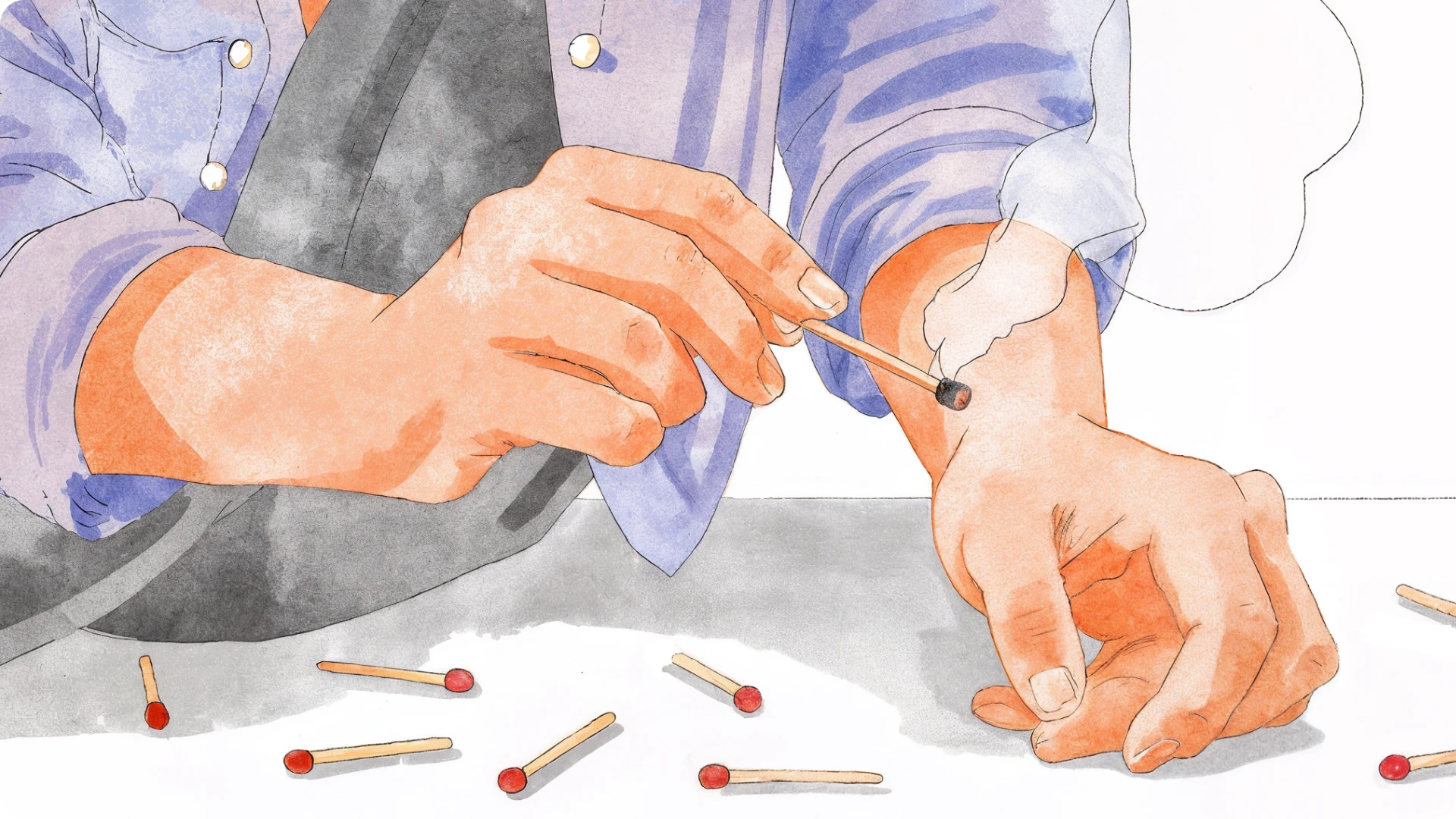Take the test to determine whether you exhibit symptoms of ADHD burnout, and then receive a 28-day personalized plan to begin reducing symptoms right away.
What is ADHD burnout?
Burnout is a state of chronic stress leading to physical, emotional, and mental exhaustion. ADHD, in turn, is a neurodevelopmental disorder with psychological aspects like impulsivity and difficulties in focusing, paying attention, decision-making.
ADHD-related burnout is a long-term condition that lasts for at least three months and is marked by fatigue, loss of function, and a decreased ability to handle stimuli. According to a recent study, people with ADHD are more likely to experience burnout. [1] People with ADHD may experience more severe burnout symptoms because their condition already impairs their ability to cope with stress and daily activities.
ADHD burnout typically manifests as a cycle of hyperactivity, inattention, impulsivity, toxic shame, exhaustion, and chronic fatigue.
Perfectionism, executive function problems, overstimulation, hyperfocus, hyperactivity, or a lack of object permanence or support can all contribute to this. Furthermore, social expectations and attempts to conform to neurotypical standards can add stress, making it even more difficult for ADHDers to cope.
What does ADHD burnout feel like?
For people with ADHD, burnout is not just something that happens to overworked office workers. The constant need for intense focus on tasks, combined with the struggle to maintain structure and routine, depletes energy at an alarming rate. Trying to stay focused and still, while following daily routines, can be difficult and quickly lead to burnout.
Also, ADHD can change the amount of dopamine. This is an important chemical that helps us stay motivated, feel positive, feel safe, control our emotions, and think clearly. Therefore, when the level is low, we might feel tired, overwhelmed, and, ultimately, burned out. [2]
Here’s how ADHD burnout can look:
- You stop enjoying the activities you used to love.
- As you take on more work, you begin to view your coworkers as enemies.
- It seems impossible to accomplish anything, so you retreat.
6 symptoms that may hint at ADHD burnout
Here are some of the common ADHD symptoms of burnout to look out for:
1. Chronic Exhaustion
While everyone feels exhausted from time to time, people with ADHD may experience burnout and a lack of energy that cannot be alleviated by rest. It is one of the most common physical symptoms of ADHD burnout. It is a chronic fatigue that can interfere with daily activities.
2. Increased Forgetfulness
ADHD burnout can manifest as increased forgetfulness and difficulty focusing. This, in turn, can lead to worsening situations such as workplace mistakes, missed appointments, and a general mess in personal organization.
3. Decreased Motivation
One of the most noticeable symptoms of burnout is a loss of satisfaction and pleasure in daily activities. This also applies to ADHD burnout. It appears to be a loss of motivation, drive, or interest in previously enjoyable activities.
4. Increased procrastination
It could take weeks or even months, and you may find yourself with a long list of tasks that can wait until tomorrow. Because impulsivity is another symptom of ADHD, procrastination avoidance is a common coping strategy among ADHDers.
5. Brain fog
Your ability to react suddenly slows. It can be difficult to remember things, organize your thoughts, and find the right words to express what you want to say. Your head feels foggy.
6. Irritability and mood swings
Sudden anger, irritability, and mood swings are other emotional dysregulation symptoms of ADHD burnout. Even minor irritations can feel overwhelming when you’re tired.

How does ADHD burnout cycle?
Burnout when having ADHD symptoms might also be cyclical. It swings back and forth between being too active and feeling desperate, between wanting to do everything and not being able to do anything.
At first, it might seem exciting, like you can do a lot of things at once. You will, however, eventually reach a standstill or experience burnout from ADHD. A pile of incomplete work starts to grow, and even the most routine tasks appear difficult. Everything we do is tinged with shame, and it leads to chronic fatigue or burnout.
Let’s examine these cycle phases in detail.
1. The Hyperactive Phase
At this stage, a person with ADHD may take on too much because new projects give them excitement (actually a dopamine rush) and make them feel good for a short time.
2. The Inattentive Phase
You were very excited and made a lot of promises earlier. You may become overwhelmed with all of this work, relationships, and responsibilities, and in an effort to keep everything running smoothly, you may begin to put things off, lose focus, or forget things.
3. The impulsive phase
In order to get a short-term dopamine boost, you may do things that will ultimately harm you, depleting your resources and raising your stress levels.
4. The shame phase
Dealing with too much at once or not paying attention can leave a lot of work undone and disappoint those around you. As a result, you may begin to feel toxic shame and guilt, which drains your energy, or lead to complete task paralysis.
5. The exhausted phase
The strain you put on yourself can cause extreme exhaustion. This stage is frequently accompanied by significant fatigue and a drop in energy and productivity.
What may be the causes of ADHD burnout?
People with ADHD can better prepare themselves to recover from ADHD burnout if they understand what actually causes it.
Here are some common causes:
1. Overstimulation
People with ADHD often feel everything around them more strongly, which can make them overly stimulated. As a result, the body’s energy reserves are depleted as the nervous system remains constantly on high alert.
Have you ever been overstimulated in a loud concert or in an overcrowded shopping center?
2. Executive function challenges
Executive functions are the skills needed to organize and act upon information (self-regulating, prioritizing, planning, decision-making, etc.). ADHD’s impact on these functions can lead to feelings of overwhelm and an inability to manage daily tasks effectively. [3] It is also hard to guess how much time and work something will require, which makes it simple to take on too much by accident.
Additionally, setting boundaries may be difficult for ADHDers. Saying “no” can be difficult for some of us because we don’t want to disappoint or be rejected. It’s known as rejection-sensitive dysphoria. Burnout may result from feeling as though we can’t manage all the tasks we are given.
3. Strive for perfection
Perfectionism is a common coping mechanism among people with ADHD. Seeking perfection can increase stress and set unrealistic and unattainable goals. Constantly attempting to meet these standards but failing can result in ADHD burnout.
4. Hyper-focus and hyperactivity
People with ADHD are more likely to hyperfocus on a single task for an extended period of time, particularly if they do not take enough breaks or relax. It has the potential to progress to burnout over time.
Hyperactivity is another core symptom of ADHD, characterized by restlessness and a constant need for movement. While it can be an asset in certain situations, it also makes it challenging to relax and unwind.
Constantly needing to be on the move prevents us from taking much-needed breaks to recharge, leading to mental and physical exhaustion.
5. Lack of Support
Sometimes, it is even harder to deal with ADHD when people around you do not understand. That is where “ADHD masking” comes in handy. It means that we try to hide or play down our ADHD symptoms to fit in with society’s expectations. This pretending also drains a lot of mental energy to leave it completely empty.
Some people with ADHD may feel alone and unable to ask for help if they do not have a network of people who can help them. It also has a great impact on burnout symptoms.
6. Work-related stress
Work-related stress is a common trigger for ADHD burnout. High-pressure environments, tight deadlines, and demanding tasks can quickly become overwhelming. Managing work-related stress is essential for maintaining a healthy work-life balance.
7. Lack of routine
A lack of routine can exacerbate ADHD symptoms, leading to increased chaos and stress. Without a clear structure, staying organized and managing daily tasks can be challenging, which can contribute to burnout.
8. Inconsistent sleep patterns
Sleep is fundamental to overall health, and inconsistent sleep patterns are a common issue for those with ADHD. Difficulty falling asleep, staying asleep, or maintaining a regular sleep schedule can all contribute to burnout.
Expert Insight
ADHD burnout can be mistaken for other conditions due to the overlapping symptoms involved. For example, fatigue, decreased motivation, and emotional dysregulation can overlap with depression and anxiety disorder symptoms and make it difficult to understand why you feel the way you do. Someone with ADHD may experience burnout in academic or work settings due to the challenges of coping in demanding environments but mistake the symptoms for general work-related stress unrelated to ADHD. Recognizing burnout ADHD-specific is essential for utilizing appropriate coping strategies and seeking the help you deserve.
Rychel Johnson
Mental health professional
Coping strategies that will help you get out of ADHD burnout
There are numerous strategies and techniques that can help prevent and recover from ADHD burnout.
Here are some practical methods to consider:
- Effective time management strategies, such as bullet journaling or the Pomodoro method (also known as the 20-minute ADHD method), can help organize work and lessen the stress that comes with a never-ending to-do list.
- Self-Care Activities: Regularly partaking in self-care activities like mindfulness, meditation, exercise, and hobbies can help prevent ADHD burnout by reviving the mind and body.
- Get enough sleep: To prevent fatigue and difficulty thinking, maintain a regular sleep schedule.
- Mindful Nutrition: Fuel your body with a balanced diet, minimizing caffeine and sugar, which can exacerbate ADHD symptoms.
- Celebrate Small Wins: Every small achievement is a step forward. Celebrate your progress, no matter how minor it may seem. This positive reinforcement can boost your motivation and morale.
- Understand Your Strengths: Individuals with ADHD often possess unique strengths, including creativity, spontaneity, and resilience. Recognize and leverage these strengths to your advantage.
- Seeking Professional Assistance: For people with ADHD, therapy like Cognitive Behavioral Therapy (CBT) can be a very helpful tool. It can assist in reframing ideas and creating coping strategies to manage burnout.
- Importance of a Strong Support Network: Educating close friends, family, and colleagues about ADHD goes a long way in fostering an environment of understanding and support.
- Try Breeze
Frequently asked questions
How long does ADHD burnout last?
The symptoms of neurodivergent burnout, also referred to as ADHD burnout, include fatigue, loss of function, and a diminished ability to cope with stimuli. These symptoms are widespread and last for three months or longer.
Can ADHD burnout look like depression?
People with ADHD burnout may feel overburdened and mentally exhausted, similar to those with depression, but they do not experience constant melancholy and hopelessness.
Can ADHD make you feel burnt out?
ADHD can cause burnout because managing focus, emotions, and daily tasks takes extra effort. For ADHDers, this constant mental strain can lead to exhaustion, low motivation, and emotional fatigue.
Sources
- Niermann HC, Scheres A. The relation between procrastination and symptoms of attention-deficit hyperactivity disorder (ADHD) in undergraduate students. Int J Methods Psychiatr Res. 2014 Dec
- Oscarsson, M., Nelson, M., Rozental, A. et al. Stress and work-related mental illness among working adults with ADHD: a qualitative study. BMC Psychiatry 22, 751 (2022)
- Scheres A, Solanto MV. Do ADHD Symptoms, Executive Function, and Study Strategies Predict Temporal Reward Discounting in College Students with Varying Levels of ADHD Symptoms? A Pilot Study. Brain Sci. 2021
Disclaimer
This article is for general informative and self-discovery purposes only. It should not replace expert guidance from professionals.
Any action you take in response to the information in this article, whether directly or indirectly, is solely your responsibility and is done at your own risk. Breeze content team and its mental health experts disclaim any liability, loss, or risk, personal, professional, or otherwise, which may result from the use and/or application of any content.
Always consult your doctor or other certified health practitioner with any medical questions or concerns
Breeze articles exclusively cite trusted sources, such as academic research institutions and medical associations, including research and studies from PubMed, ResearchGate, or similar databases. Examine our subject-matter editors and editorial process to see how we verify facts and maintain the accuracy, reliability, and trustworthiness of our material.
Was this article helpful?






